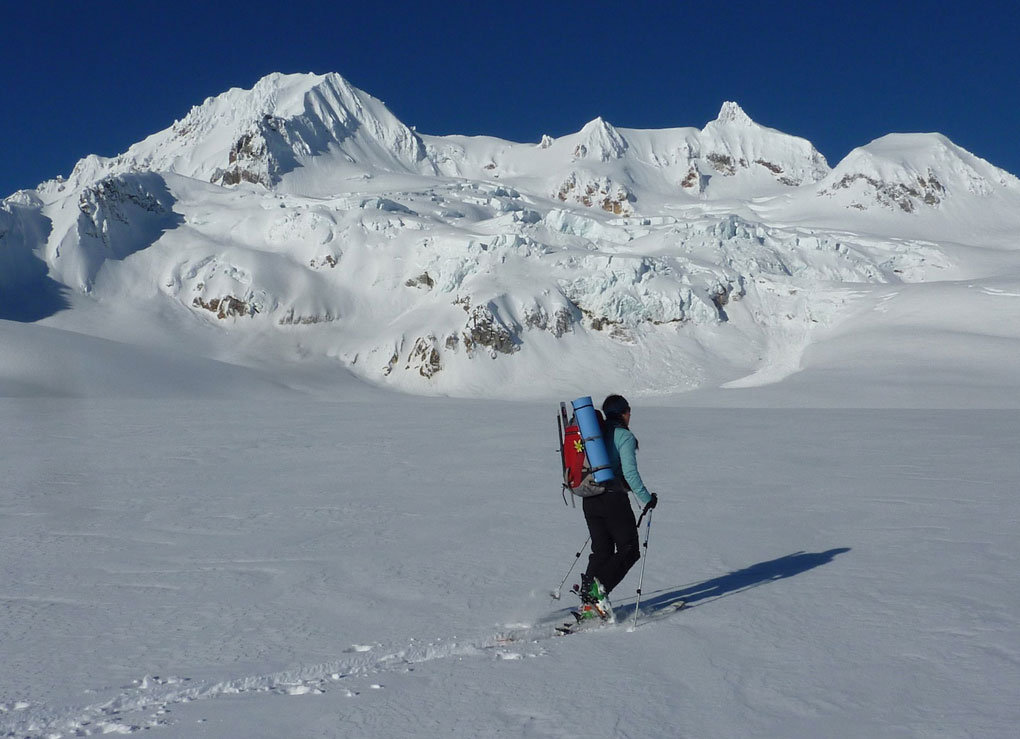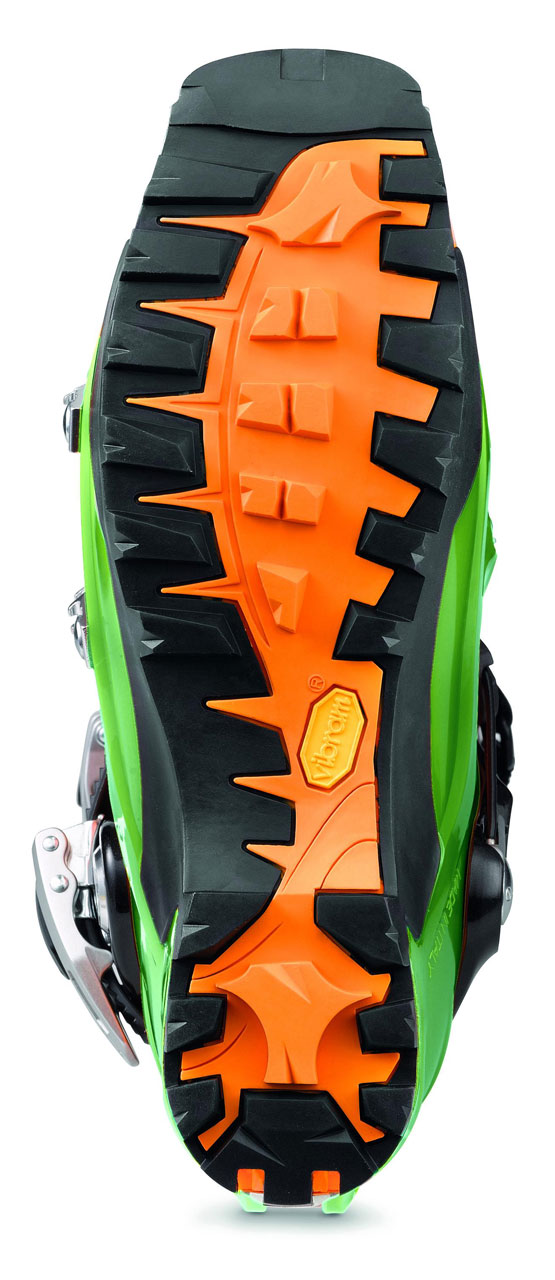Hiking and the Uptrack
My first tour up sun-cupped August snow felt like a summer hike. With the boots in walk mode and the upper boot completely tightened, the range of motion is quite large—farther than I can effectively stride. Not only is this beneficial for approaches on foot, it also contributes to the general comfort of the boot.

I am used to dealing with blisters in all stiff footwear because of my knobby heels, but I was ecstatic to discover that I suffered from minimal hot spots after my first big tour in the Gea: 3,200 vertical feet gained and lost over 5.5 miles.
I really got to put the Gea’s hiking abilities to the test in November 2012, when I embarked on a glacier-traverse attempt east of Pemberton, BC. My partner and I expected to be able to have our skis on for the majority of the 8-mile-long trip, but the conditions were not conducive to skinning. We spent the first two hours hiking up a steep forest trail on tree roots and frozen puddles, which were covered in everything from a dusting to five inches of powdery snow.
For the next two hours we blindly boulder-hopped up a glacial moraine, balancing with our skis on our backs and both poles gripped in our hands as we tried to predict our footing under the snow. We strapped on crampons for a short scramble of thin ice, then we were finally able to put on skis for a whole 200 meters of skinning before a steep glacier mandated another boot-pack. After seven hours, we turned around after having covered only a discouraging three miles, and repeated the torture in reverse.
The Geas were on my feet that day for 15 brutal hours. Balancing up root steps in the woods was not a problem, and I was able to creep my way over frozen creek flows with little difficulty. The range of motion during these times was paramount as I hopped creeks and climbed roots, and the Gea delivered. While I was teetering on the snow-covered moraine, the Gea took a beating from grinding into rocks on all sides, probably aging them some 15 touring days. As a result, both ratcheting buckles for the plastic ankle straps are now a bit bent and loose. This probably would have happened to the burliest of boots since I was pretty rough on them in the rocks, and total damage would have been worse if the buckles weren’t reverse oriented, but it did make me wonder about the lightweight materials.

The soles have an aggressive pattern that provides excellent traction in snow and dirt, yet is soft enough that I can feel the larger pointy rocks when I step on them with my forefoot. This softness does not extend to the stability (laterally or medially) in the boot; it seems to simply be a product of the lightweight build, and allows better balance when walking around.
A final bonus of these boots is their long-term comfort. After those brutal 15 hours, my feet hurt less than a five-hour mountain hike in running shoes. My knees didn’t ache, and I didn’t suffer from a single blister. When I start to feel a hot spot developing, I simply tighten down the instep strap to keep my heel from rising while touring, and so far, I’ve been good to go.
Even after so many days in these boots, I am still amazed at their light weight and flexibility when touring.
The Descent
When I first descended on the Gea, I didn’t particularly like how they felt. But it was also the first time I made the transition from a heavy alpine boot to a feather-light setup. I realize now that I also wasn’t as strong of a skier then, so my incompetence on the descent wasn’t purely because of the boots. When I returned to the Gea after a few months awaiting a warrantee return (more on that in a minute), my skiing had improved, and I felt no hesitation on a 40-degree corn-snow couloir. I felt like I had sufficient energy transfer from my body into my skis, and was excited for more.
After that successful reunion with the Gea, I have toured for an additional 30+ days and skied at least four demanding (40 degree plus) alpine lines in them. I’m now skiing much more aggressively than I was seven months ago, and unsurprisingly, these boots are feeling significantly softer now that I’m skiing harder.
The Gea is rated at a 100 flex, and I have found that, for me, it is not beefy enough to ski terrain such as steep and varied trees in thick coastal snow. The softness forces me to improve my balance while skiing, which is not as noticeable of a problem on smooth slopes. However, when the terrain starts throwing curve balls, it leaves me wanting something more supportive.
That said, SCARPA now offers the Gea RS, which has a rated 120 flex and designed for harder-charging backcountry skiing.
Liners
The stock Intuition liners have been very warm and comfortable since day one. Inactivity in a zero-degree winter camping situations hasn’t resulted in cold toes. I never heat-molded them, and have never had problems with unhappy feet. Gradually the liners have packed out to the slightly sloppy situation I now find myself in, and I’m a little disappointed that this has happened so soon. The combination of more spacious liners and a boot of only 100 flex has me flopping into the extremes of forward and aft more frequently that I would like, an issue exacerbated when I ski with a heavy overnight pack, and by the technicalities of dodging trees. I am now adding a thin pair of socks to my normal ski socks and find that this takes up an acceptable amount of space.
Durability
I initially toured on the Gea for five relatively short trips until, on one white-out and flat light summit, my left boot would not engage into skiing mode. That night, in the warmth and dryness of my home, I forced it into skiing mode and left it there for a few more tours and resort days until I shipped the boots off to SCARPA warrantee around Christmas.
The exposed and thin metal bar of the ski/walk switch on the back is subject to all of the elements as well as injury from the environment. While plunge-stepping down a steep forest trail, I worry about crunching it into rocks or roots. I’ve noticed now that after every five to ten tours I need to thoroughly wipe the bar down with some WD-40 or other equivalent oil/grease, plus drip some of the oil onto the top of the bar inside of the shell. This is the only way to reduce squeaking, rubbing, and slow the wear on the parts.
After my Geas were returned, I was, and am still, happy with the transition to ski mode. There is no lingering doubt of a failing transition, and every changeover has been a solid one.
Sometime around my 25th tour, however, one of the plastic ankle straps broke in half. I survived with a ski carry strap around my ankle for a couple of weeks until SCARPA mailed me replacement straps. The beauty of this situation is that I could change out the straps by myself without anything fancier than a couple of Allen wrenches. Even so, I was surprised that these straps were the next failure in the system—the plastic simply snapped in the middle of the teeth during a pretty warm tour.
SCARPA Gea vs. Black Diamond Shiva
While my Geas were under warranty, I skied the 2010-2011 Black Diamond Shivas for four months. I loved the smoothness of the Shiva walk function, and the assurance I got from a solid click from walk to ski mode. The Shivas were silent while touring compared to the squeaky Gea, and the touring mode felt smooth.
While both the Gea and the Shiva are rated as a 100 flex, the Shivas are beefier and generally felt more solid to me, and were a better fit for my aggressive style. I skied Whistler for 30+ days in the Shivas and never worried about durability.
The Gea, however, was superior to the BD Shiva on the uptrack, as the Shivas weighed an extra 2.5 pounds per pair. The Shivas also had a wimpier sole for tromping around without skis on, and a Boa lacing system on the liner that I, at least, found to be a bit more of a hassle than a help. And after 40 tours over four months in the Shivas, I had completely worn through their liners at the heel to the point where my heel was against plastic.
The Shiva is a better do-it-all boot than the Gea, in my opinion, but the Gea rocks the world of lightweight touring.
Bottom Line
The SCARPA Gea is a touring boot, through and through. If you are looking to tour exclusively for multiple, demanding descents, this might not be the best option (and if you’re a hard charger, the stiffer Gea RS might be a better choice). But on long traverses or ski mountaineering trips, where the emphasis is on touring / hiking / scrambling more than skiing rowdy lines, the Gea’s light weight and comfort are exceptional. They shine on long tours when every ounce counts.
